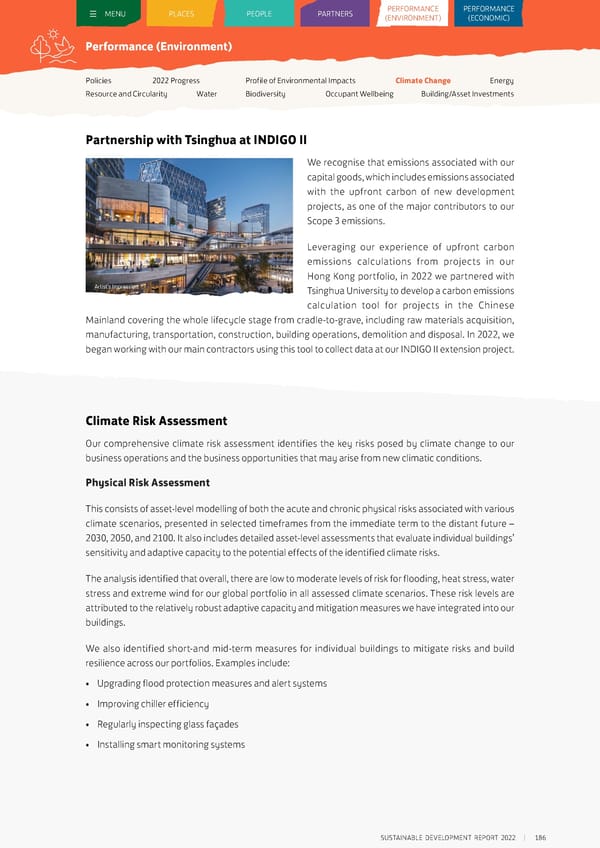MENU PLACES PEOPLE PARTNERS PEPERRFOFORRMMAANNCCEE PERFORMANCE ((ENENVVIIRROONNMENMENTT)) (ECONOMIC) Performance (Environment) Policies 2022 Progress Profile of Environmental Impacts Climate Change Energy Resource and Circularity Water Biodiversity Occupant Wellbeing Building/Asset Investments Partnership with Tsinghua at INDIGO II We recognise that emissions associated with our capital goods, which includes emissions associated with the upfront carbon of new development projects, as one of the major contributors to our Scope 3 emissions. Leveraging our experience of upfront carbon emissions calculations from projects in our Hong Kong portfolio, in 2022 we partnered with Tsinghua University to develop a carbon emissions calculation tool for projects in the Chinese Mainland covering the whole lifecycle stage from cradle-to-grave, including raw materials acquisition, manufacturing, transportation, construction, building operations, demolition and disposal. In 2022, we began working with our main contractors using this tool to collect data at our INDIGO II extension project. Climate Risk Assessment Our comprehensive climate risk assessment identifies the key risks posed by climate change to our business operations and the business opportunities that may arise from new climatic conditions. Physical Risk Assessment This consists of asset-level modelling of both the acute and chronic physical risks associated with various climate scenarios, presented in selected timeframes from the immediate term to the distant future – 2030, 2050, and 2100. It also includes detailed asset-level assessments that evaluate individual buildings’ sensitivity and adaptive capacity to the potential effects of the identified climate risks. The analysis identified that overall, there are low to moderate levels of risk for flooding, heat stress, water stress and extreme wind for our global portfolio in all assessed climate scenarios. These risk levels are attributed to the relatively robust adaptive capacity and mitigation measures we have integrated into our buildings. We also identified short-and mid-term measures for individual buildings to mitigate risks and build resilience across our portfolios. Examples include: • Upgrading flood protection measures and alert systems • Improving chiller efficiency • Regularly inspecting glass façades • Installing smart monitoring systems SUSTAINABLE DEVELOPMENT REPORT 2022 186
 Sustainable Development Report 2022 Page 186 Page 188
Sustainable Development Report 2022 Page 186 Page 188